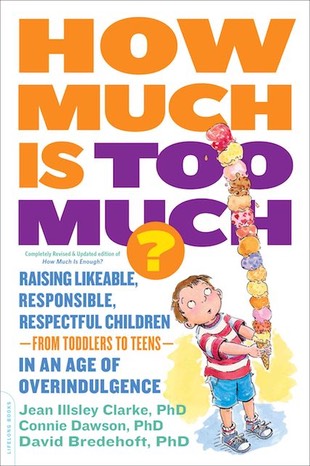Sara and her Dad took a shortcut through the department store on the way back from Sara’s dance lesson. Sara spied a doll display. Her eyes fell on a doll she wanted, no, needed. Dad said, “No. I’m not buying any more dolls. You don’t play with the ones you have.”

That answer was not the one Sara wanted. She was undeterred. More whining and more pressure. Dad relented and bought the doll. There was no joy on his face.
Dad’s vague (or not so vague) resentment is a huge clue that he could use a way to think about when to buy and when not to buy.
How does a parent, or anyone, for that matter, decide where to draw the line? Answer: when one of the parties agrees to something and then harbors a resentment. That feeling signals, “Stop. Hold it. There’s a problem here.” That is the place to draw the line.
What’s Too Much?
What if Sara’s Dad had a framework to use when deciding what was good for his daughter? Think about this one:
· If Sara has too little of something, she doesn’t have what she needs for survival or for
growth.
· If Sara has enough things, nurture, and structure, she has what she needs to grow and
thrive. “Enough” is a condition of sufficiency.
· If Sara has Enough, she can joyfully experience abundance, which is more than Enough.
Abundance is a breakthrough from Enough. Abundance is having more than enough now
and then. Once in a while.
· If Sara experiences Abundance on a chronic basis, she has too much. This is
overindulgence.
What’s wrong with having Too Much?
Having Too Much all of the time means not having the chance to experience the joy and celebration of occasional Abundance. Being chronically overindulged with Too Much results in joylessness and the perception that whatever IT is, it’s never enough. When a person has Too Much of anything, all becomes as nothing.
Chronic Too Much is not good for kids. It may look good and even feel good at the time, but it has long-term negative consequences. The adults overindulged as children who were subjects in the studies of The Overindulgence Research Project revealed that not knowing what is Enough was a big reason for the pain and difficulties they had had and were having.
What’s the difference between Abundance and Too Much? (overindulgence)? Overindulgence is immersion in having too much all the time - including having someone over-function for you when you are capable of functioning for yourself, and being excused from doing chores, from complying with rules, from learning skills and from being a contributing and cooperative family or group member.
Dad decides what’s best
Sticking with the domains of Enough and Abundance can help Dad know what is in Sara’s best interests. And his own! When Dad sticks with a No for the sake of his child, Dad gets to have a smile in his heart, even when Sara has a frown on her face.
We know how annoying some children can be in order to get what they want. Bless their hearts. It’s perfectly okay that they ask. And it’s perfectly okay that they have a disappointed look when they're told, “Honey, you have enough dolls.”
Will children escalate annoying behaviors to get what they want (even though they may think it’s what they need.) Probably. If a parent has decided what is Enough, rest assured the Yes and the No will be based on what is good for the child. Resist pressures with good humor and a stalwart heart.
Tips for Parents
- Have the discussion with co-parents about the lines between Too Little, Enough, Abundance and Too Much.
- Talk with other parents about their views on the four markers of knowing what is Enough.
- If you need to counter your peers and your child’s peers, hold your own!
- Do not undermine a co-parent’s credibility. If you don’t agree, work out your differences privately. Do not conduct your disagreements through your child.
- Being clear about your values and understanding of what each child needs will help you know what is Enough.
Remember that when everything is Too Much all the time, it’s NEVER enough!
There is more help about avoiding overindulgence in How Much is Too Much? Raising Likeable, Responsible, Respectful Children – From Toddlers To Teens – In An Age of Overindulgence (2014, DaCapo Press Lifelong Books).
All photos from MorgueFile free photo.


